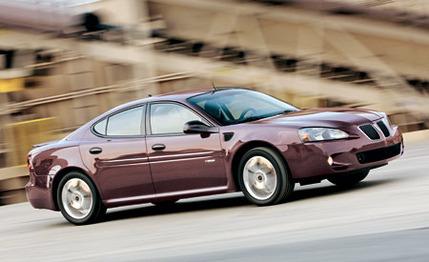
 Road Test
Road Test
The obvious part of the formula is obviously far from new: Cram a big ol' V-8 in there, make the car go faster. Detroit has been doing this since the '60s. But what may not be so obvious is that there's a big asterisk to the formula when you start applying it to a front-wheel-drive car. The footnote reads something like this: "Put enough power through a front-drive system, and the driver will find himself turning right or left when he was planning on straight ahead."
It's called torque steer, and it's the major limiting factor in front-drive performance cars. Despite various engineering advances, the problem persists in cars such as Acura's otherwise superb TL, which sends 270 horsepower through a six-speed manual transmission to the front wheels via a helical limited-slip differential. But in the Grand Prix GXP, with more horsepower (303 at 5600 rpm) and a lot more torque (323 pound-feet at 4400 rpm), torque steer is not a serious issue. There are hints-a little tugging when the driver cracks the throttle at low speed-but no real wrestling.
How'd they do that? By adopting a measure no one else has ever put into production. More in a minute. But first, another front-engine, front-drive problem, one that's even more chronic than torque steer. With a design that puts all the heavy powertrain hardware up front, front-drive cars invariably have a pronounced forward weight bias, 64/36 percent in this case. As a consequence, the front wheels carry more than their fair share of the car's mass, diluting the ability of the tires to transmit steering inputs. Worse, the front tires are also required to transmit power to the pavement, and all things being equal, the poor things just can't handle their multiple assignments as well as the front tires of rear-drive cars. The result is understeer. The faster the driver herds the car into a turn, the more it wants to go straight.
Pontiac's solution to these two inherent front-drive directional control problems-understeer and torque steer-is unique. Instead of four tires of equal size, the GXP has a lot more rubber up front than at the rear: Bridgestone Potenza RE050As, 255/45-18 front, 225/50-18 rear.
"We wanted a car to run with BMWs," says program engineering manager Phil Minch. "But we were limited by the W-car architecture, in other words, by front-wheel drive.
"The rear end never lets go when you have the same size tires all around. So we put our computer guys on it, and they came back with a recommendation for a smaller rear tire, to give the car better balance."
This is a radical departure from conventional wisdom, and the idea proved out in initial testing. But there was a nasty side effect: Increasing the contact patch at the front amplified torque steer. However, after experimenting with a number of different tires from a variety of manufacturers, Minch and company decided the problem lay in the tire's construction-the way the plies were wrapped-and not the footprint. With sufficient application of power, the tire sidewalls distort, thus affecting directional stability.
Bridgestone, the supplier of choice, was initially reluctant to accept this theory, but when the GXP team achieved improved results using an off-the-shelf tire from another maker, the Bridgestone people got to work and developed a tire that delivered the desired performance.